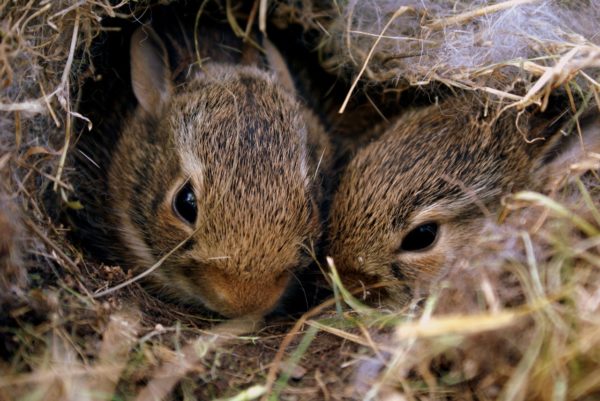How to Identify Orphaned Rabbits
by Ontario SPCA and Humane Society | Wildlife Fact Sheets | March 19, 2019
 It is not uncommon to find nests of young rabbits in your yard or garden. Despite popular belief, cottontail rabbits do not burrow to create dens, but nest on the surface of the ground. Typically, female rabbits will find a small depression or hollow in the ground and will line the area with fur to use as a nest. Often these nests are found in the middle of open areas such as lawns or playing fields. If you find a group of baby rabbits lying in such a space, they are in their natural nest and do not necessarily need assistance. A nest of younger rabbits (i.e. not fully furred, do not have eyes open) should be left alone if there is any chance that the mother might return. Mother rabbits return to the nest site at dusk and dawn to feed young, therefore you may never actually see the mother at the nest site.
It is not uncommon to find nests of young rabbits in your yard or garden. Despite popular belief, cottontail rabbits do not burrow to create dens, but nest on the surface of the ground. Typically, female rabbits will find a small depression or hollow in the ground and will line the area with fur to use as a nest. Often these nests are found in the middle of open areas such as lawns or playing fields. If you find a group of baby rabbits lying in such a space, they are in their natural nest and do not necessarily need assistance. A nest of younger rabbits (i.e. not fully furred, do not have eyes open) should be left alone if there is any chance that the mother might return. Mother rabbits return to the nest site at dusk and dawn to feed young, therefore you may never actually see the mother at the nest site.
Determining if the mom is still caring for the rabbits
In order to determine whether a mother rabbit is still in the area and providing care, place two pieces of string across the nest site in an “X” pattern. If the string has been shifted out of place during the next 24 hours, you will know that the mother has returned at some point and fed the young. You may also wish to place flour around the nest site and check for footprints of the adult rabbit. If the area is undisturbed for more than 24 hours, or if the young appear thin and weak, contact your local wildlife rehabilitator for next steps.
Identifying rabbits outside the nest
You may also see very small rabbits hopping around and think they are too young to be out in the world on their own. If the rabbit(s) is covered with fur and is approximately four-and-a-half to five inches in length, the rabbit is independent from the mother and does not require human intervention, unless injured. Although these young rabbits appear too small to be on their own, cottontails are fully weaned and leave the nest when they are only 21 to 28 days old.
Note: Whenever young mammals are found, an attempt should be made to reunite them with their parent(s). Parents provide the best care for young wildlife and when young are inadvertently removed from their parents, it decreases the likelihood that they will survive, even with expert human care. Each wildlife species has its own specific needs and requires specialized care to recover.
Categories
Testimonial
Speaking for the ones who can’t speak for themselves
Keep up the good work speaking for the ones who can’t speak for themselves. A society who cares for their animals is a better society. Thanks for your good work!